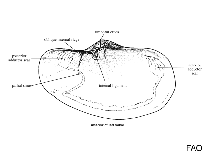Laternula marilina (Valenciennes, 1860)
Littoral spoon clamGoogle image | No image available for this species;
drawing shows typical species in Laternulidae.
Classification / Names Common names | Synonyms | CoL | ITIS | WoRMS
Bivalvia | Not assigned | Laternulidae
Environment: milieu / climate zone / depth range / distribution range Ecology
Benthic, usually 0 - 25 m (Ref. 75831). Subtropical
Distribution Countries | FAO areas | Ecosystems | Occurrences | Introductions
Indo-Pacific.
Length at first maturity / Size / Weight / Age
Maturity: Lm ? range ? - ? cm
Life cycle and mating behavior Maturity | Reproduction | Spawning | Eggs | Fecundity | Larvae
Main reference
References | Coordinator | Collaborators
Zhuang, S., M. Zhang, X. Zhang and Z. Wang 2004 The influence of body size, habitat and diet concentration on feeding of Laternula marilina Reeve. Aquaculture Research 35:622-628. (Ref. 77827)
IUCN Red List Status
(Ref. 130435: Version 2025-1)
CITES status (Ref. 108899)
CMS (Ref. 116361)
Threat to humans
Human uses
| FishSource |
Tools
More information
Diet composition
Food consumption
Predators
Max. ages / sizes
Length-weight rel.
Length-length rel.
Length-frequencies
Mass conversion
Abundance
Internet sources
BHL | BOLD Systems | CISTI | DiscoverLife | FAO(Publication : search) | Fishipedia | GenBank (genome, nucleotide) | GloBI | Gomexsi | Google Books | Google Scholar | Google | PubMed | Tree of Life | Wikipedia (Go, Search) | Zoological Record



